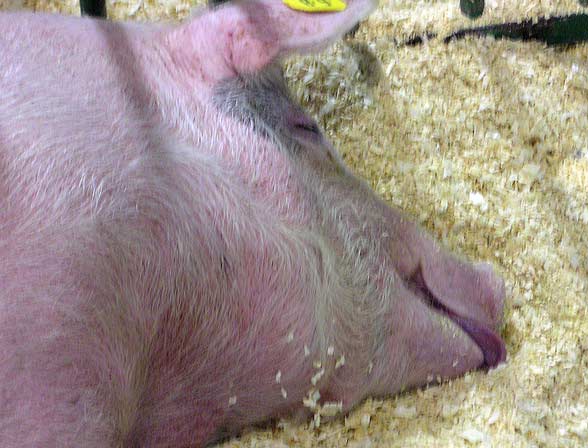Swine biosecurity
Swine biosecurity: August 2007 -- An efficient and effective swine herd health program addresses proper nutrition, housing, and ventilation; animal welfare and comfort; appropriate pharmaceutical use; and disease prevention and control strategies. Biosecurity is the cornerstone of disease prevention. By implementing biosecurity precautions, the herd can be protected from the entry of potentially devastating diseases such as porcine respiratory and reproductive syndrome, classical swine fever, brucellosis, pseudorabies and circovirus infections. The biggest threat is purchased pigs that may harbor infectious agents, without exhibiting overt clinical signs. Wildlife, pets, people, inanimate objects, and wind can carry disease-causing organisms onto a swine facility. The California Department of Food and Agriculture’s (CDFA) Animal Health Branch, in partnership with the National Pork Producers Council, State associations, the United States Department of Agriculture (USDA), and University of California Cooperative Extension are committed to assisting producers in developing biosecurity strategies. The following biosecurity principles may be tailored to meet the individual producer’s situation.

Quarantine New Additions:
. Work with your veterinarian to determine the health status of the source herd and individual animals that you are purchasing.
. Isolate newly purchased breeding stock, as all-in/all-out for a minimum of 60 days.
. Clean and disinfect the isolation facility between groups of new additions.
. Use the isolation period to medicate and test new additions to assure their health status before exposing your herd to them.
Manage to Prevent Disease:
. Use all-in/all-out air space.
. Thoroughly clean and disinfect each room or building between groups of hogs.
. Maintain good air quality.
. Work with your veterinarian to develop:
- Vaccination programs,
- Internal and external parasite control programs,
- Treatment plans for common veterinary conditions,
- Routine herd blood testing, and
- Post-mortem examinations with follow-up diagnostic procedures to monitor herd health and track causes of mortality.
. Humanely destroy sick or injured pigs that will not recover or may serve as potential reservoirs of disease for other pigs on the facility.
. Provide ample, potable water.
. Dispose of dead animals within 24 hours of their death.
. Identify a designated area, outside of the perimeter of the facility, for the rendering truck to pick up carcasses.
Maintain a Vermin Control Program:
. Clean up feed spills promptly.
. Replace lids and covers of feeders.
. Seal holes in walls and doors.
. Keep records of rodent bait stations:
- Track numbers of rodents trapped
- Track frequency that bait is changed
. Control access of birds and cats to your facility.
Waste Management Determine if:
. Manure management and the use of wash water are inadvertently spreading disease between groups of pigs in the facility
. Manure management for animals isolated as new additions is prematurely exposing the herd to these animals. The isolation area should have a separate manure holding area until animals are released from isolation and added to the herd.
Facility Biosecurity:
. Limit the number of visitors to your facility.
. Provide clean overalls, head covering, and boots for employees and visitors. Provide shower facilities, if possible.
. Do not allow employees or visitors to enter the facility wearing rings or watches. They are difficult to completely disinfect.
. Establish a traffic pattern for employees and visitors that prevent exposure of young hogs to older animals.
. Provide effective boot disinfectant solutions and dedicated protective clothing at high-risk areas in the facility (such as the nursery and farrowing house).
. Change clothing and shower after visiting other farms, livestock markets, or livestock fairs and shows.
. Do not allow unnecessary vehicles to enter your facilities. Make sure trucks are clean when they arrive at your farm.
. If you transport your own hogs to market:
- Wear protective clothing while unloading.
- After unloading, put contaminated clothing in a plastic bag in your truck until they are washed or disinfected.
- Do not let hogs run off and then back on the truck while at the market.
- Wash your truck before returning to your facility.
. It is not recommended that animals leaving your facility be allowed to return. However, if this occurs, isolate these returning animals as new additions.
Participating in Fairs and Shows:
. Allowing hogs to participate in fairs and shows and then return to your facility increases the risk of an infectious disease entering your herd.
. Animals returning from a site where swine have co-mingled should be isolated as new additions.
. Your veterinarian will assist you in developing a plan to test and monitor the animals for a period of time (60 days minimum) before they re-enter the herd.
This article hasn't been commented yet.


Write a comment
* = required field